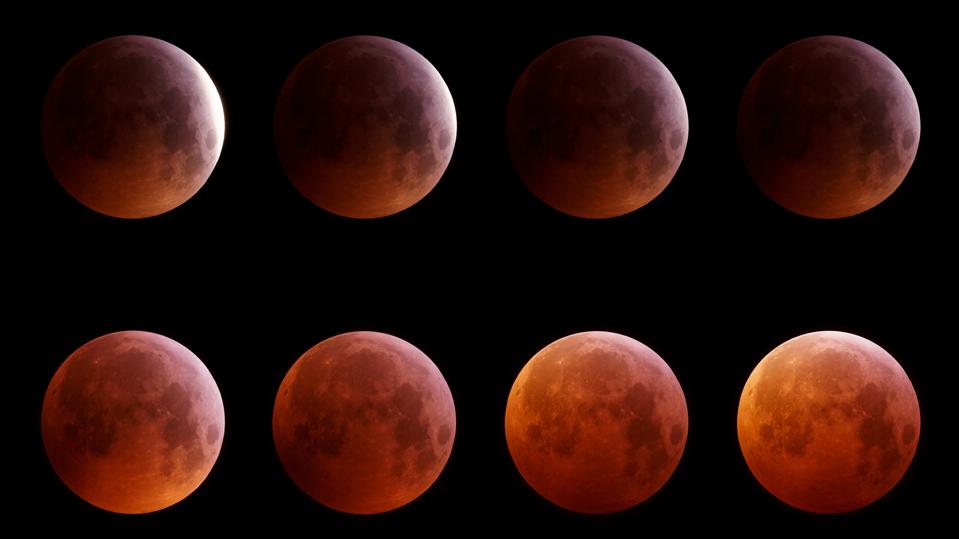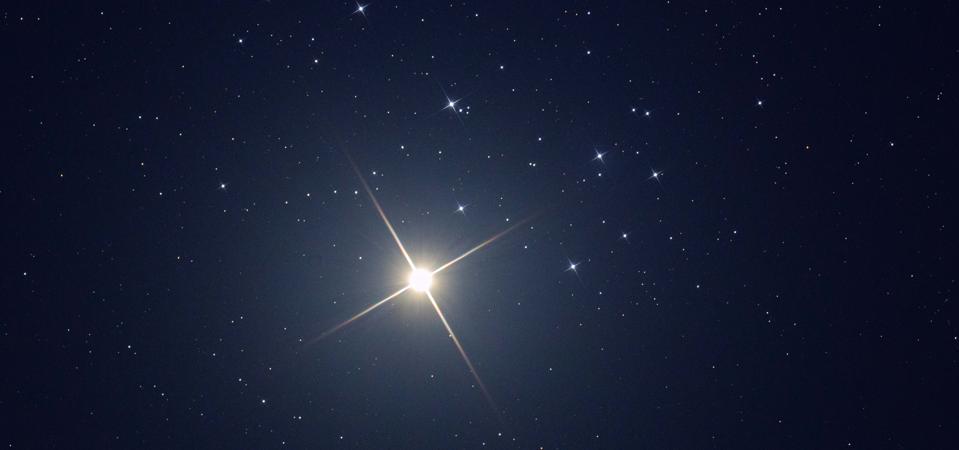
Total lunar eclipse on January 21, 2019, photographed from Mannheim in Germany.
gettySummer stargazing is here. The nights may be getting shorter as we countdown to the summer solstice, but the final month of spring in the northern hemisphere this year sees two of 2021’s biggest astronomical events.
The year’s biggest “supermoon” on May 26, 2021 is surely one of them, a sight that for half the world will be merely the largest-looking and brightest full Moon of the year. For others—notably those in the western half of the U.S.—that “Super Flower Moon” will also be a rare total lunar eclipse during which our satellite will turn a reddish-orangey colour for 15 minutes.
Add the return of an unbelievably bright Venus to the post-sunset sky, a rare view of Mercury in the “Seven Sisters” star cluster, and a close planetary “kiss”—or conjunction—between both of the inner planets, and the month of May is set to stun.
Here’s everything you need to know about when and where to look for the finest planetary and Moon sights in May 2021:

Venus embraces the Pleiades, as seen from China on April 3, 2020. This month a similar sight will be ... [+]
Barcroft Media via Getty Images1 – Mercury in the ‘Seven Sisters’
When: Just after sunset on Tuesday, May 4, 2021
Where: low on the northwest horizon
MORE FOR YOU
The smallest, hottest and fastest-moving planet is in for a great May. It’s going to get as far from the Sun as it almost ever gets, which makes it a great month to tick “the Swift Planet” off your list. Tonight, right after sunset, it will be about 2° from the Pleiades open cluster of hot, blue young stars—also known as the “Seven Sisters”—low down in the west-northwest. You can also look on Wednesday and Thursday when Mercury and the Pleiades will still be relatively close. Wait until the Sun has gone down and use binoculars.

A crescent Moon, Venus and Mercury
Jamie Carter/Stellarium2 – A crescent Moon, Venus and Mercury
When: just after sunset on Wednesday, May 12 and Thursday, May 13, 2021
Where: low on northwest horizon
Are you always among the first to spot the ‘young Moon’? A badge of honour among some keen-eyed moon-gazers, there’s an extra prize for anyone out hunting for a 1%-lit crescent Moon in the post-sunset sky on May 12, 2021 in the form of the planet Venus just 1º above. A much easier sight will occur 24 hours later when a 3.5% crescent Moon will be visible just next to Mercury, and above Venus. You’ll need binoculars. This is also the New Moon that signals the end of the Islamic fasting month of Ramadan 2021.

Venus will return to the post-sunset night sky this May 2021 and remain there for months.
getty3 – Venus as a brilliant ‘Evening Star’
When: all month
Where: in the west after sunset
After spending the first half of 2021 as a super-bright object in the pre-sunrise night sky as a “Morning Star,” the second rock from the Sun this month emerges into the post-sunset sky as a brilliantly bright “Evening Star.” By May it will be very, very bright and inch towards Mars. In fact, Venus will be blazing at magnitude -3.9. We’re in for a spectacular summer performance from Venus, though it will sink earlier each month and gradually slim to a crescent by December as Earth and Venus get close to each other.

During May, Mercury will reach its highest position in the night sky for 2021.
Jamie Carter/Stellarium4 – Mercury highest in the night sky
When: just after sunset on Saturday, May 15, 2021
Where: low on northwest horizon
The “Swift Planet” will be most easily seen just above the western horizon right after sunset. Don’t hang about because it will sink quickly. This is the best night to see Mercury in its current April-June apparition, which is the best of 2021.

People gather to watch a "blood moon" eclipse in Melbourne on July 28, 2018.
AFP via Getty Images5 – A ‘Super Flower Blood Moon’ total lunar eclipse
When: early hours of Wednesday, May 26, 2021
Where: southwestern sky from West Coast U.S.
A “supermoon” will move into Earth’s dark central umbral shadow to cause a total lunar eclipse—the first for over two years—for a mere 15 minutes, briefly turning the lunar surface a reddish-copper color, though only for those in western parts of North America. If the sky is clear it’s surely going to be the most arresting sight of 2021 for anyone on the night-side of Earth at the moment of this global event—and that means those in Australia, parts of western U.S. states, western South America and Southeast Asia. Everyone else on Earth will see a fabulous moonrise in the east at dusk, but no “blood” moon.

Mercury and Venus feature in a one-night-only close conjunction on May 28, 2021.
getty6 – A planetary ‘kiss’ between Venus and Mercury
When: after sunset on Friday, May 28, 2021
Where: low on northwest horizon
After dusk tonight the tiny planet Mercury dramatically sinks back towards the Sun and, as it does, glances the super-bright planet Venus. Look west after sunset and you’ll see the two planets barely 0.5º apart, and getting closer. However, do bear in mind that Venus will be brilliantly bright compared to Mercury, so it’s a bit of a mis-match.
Times and dates given apply to mid-northern latitudes. For the most accurate location-specific information consult online planetariums like Stellarium and The Sky Live. Check planet-rise/planet-set, sunrise/sunset and moonrise/moonset times for where you are.
Wishing you clear skies and wide eyes.
The Link LonkMay 01, 2021 at 09:00AM
https://www.forbes.com/sites/jamiecartereurope/2021/04/30/a-super-blood-moon-eclipse-and-an-impossible-planetary-kiss-your-guide-to-the-moon-and-planets-in-may-2021/
A ‘Super Flower Blood Moon’ Eclipse And An Improbable Planetary ‘Kiss’: Your Guide To The Moon And Planets In May 2021 - Forbes
https://news.google.com/search?q=Flower&hl=en-US&gl=US&ceid=US:en

No comments:
Post a Comment